1lumen selects and reviews products personally. We may earn affiliate commissions through our links, which help support our testing.
Fenix LR50R review
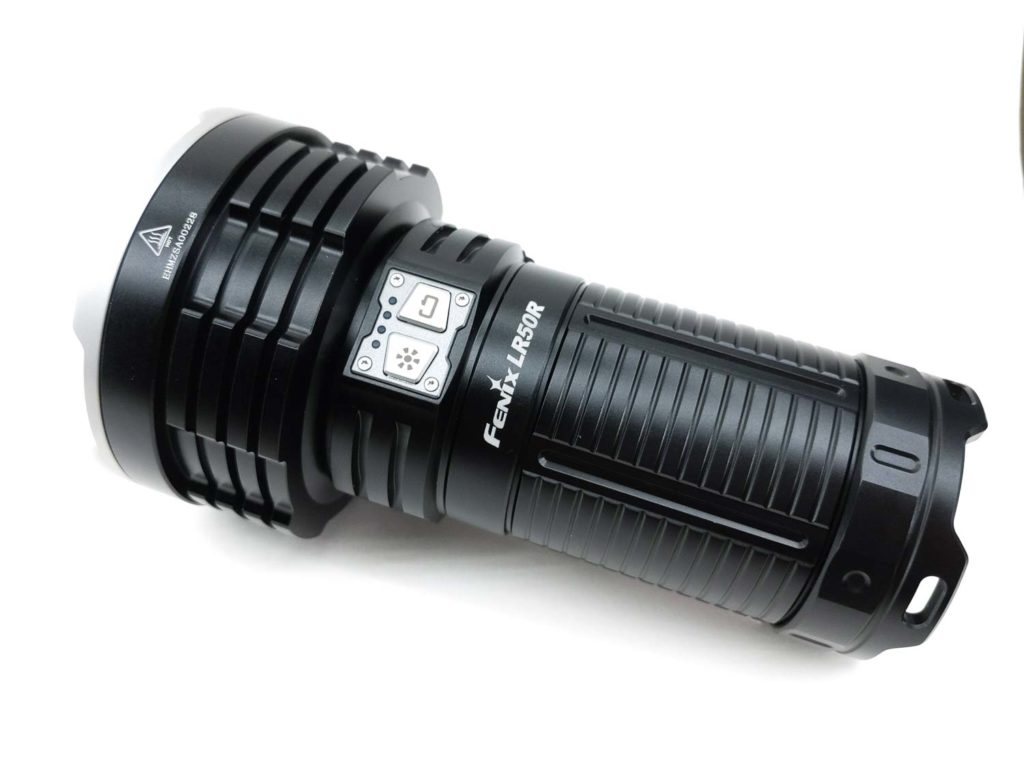
Fenix LR50R specifications
| Brand/model | Fenix LR50R |
|---|---|
| LED | 4x Luminus SST70 |
| Lumens | 12,000 Lumens |
| Beam intensity | 225,750 cd |
| Battery config. | Battery pack / 1-4*21700 |
| Material | Aluminum |
| Modes | 6 |
| Blinkies | Strobe, SOS |
| Reflector | Smooth |
| Waterproof | IP68 |
| Review date | April 2021 |
Introduction:
Fenix has been creating a wide array of flashlights, headlamps, and other lights for over 20 years. While they are one of the more well-known names in the tactical space (with their TK series), Fenix also produces professional-oriented lights (PD Series), EDC-style lights (E Series), and numerous others. In fact, my first ever “real” LED flashlight was the Fenix E25 which has faithfully served me for many years. Today, I have the brand-new Fenix LR50R at hand. Based on the other entries to the LR Series, I’m going to go out on a limb and say that “LR” stands for “Long Range”. But just how well can this high-lumen, multi-emitter light throw? Let’s find out, shall we?
Package quality.
For a flashlight in this price range, you expect nice packaging even if the packaging really isn’t all that big of a deal. Fenix did not disappoint! The LR50R arrived in a large, two-piece nested box with plenty of images, designs, and information on the outside. On the inside was a dense foam, custom-cut for this application. Foam aside, the box contained:
- Fenix LR50R flashlight
- Fenix ARB-L52-16000 rechargeable Li-ion battery pack (16000 mAh)
- USB Type-C charging cable
- Lanyard
- Holster
- Shoulder strap
- Spare O-ring
- Manual
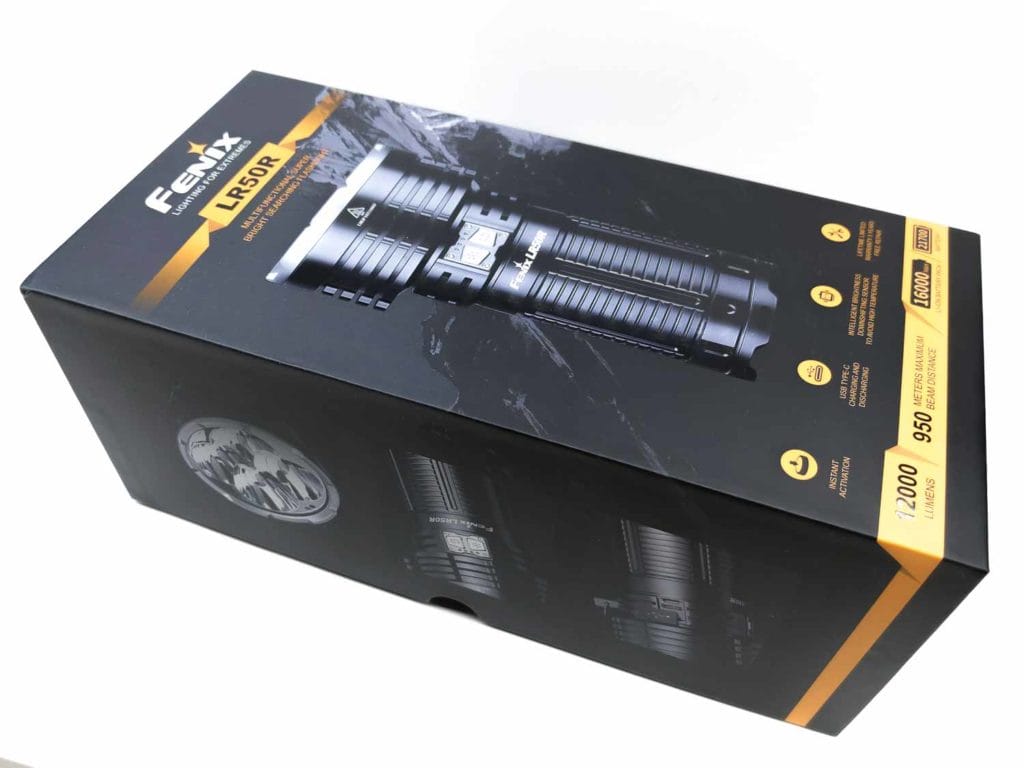
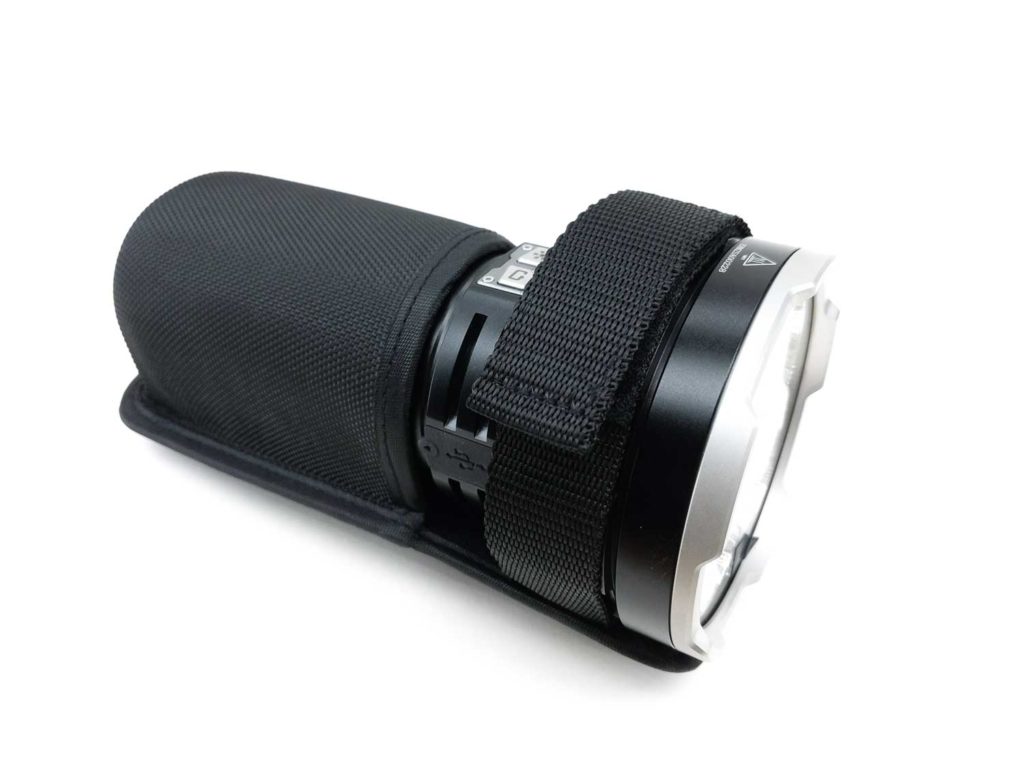
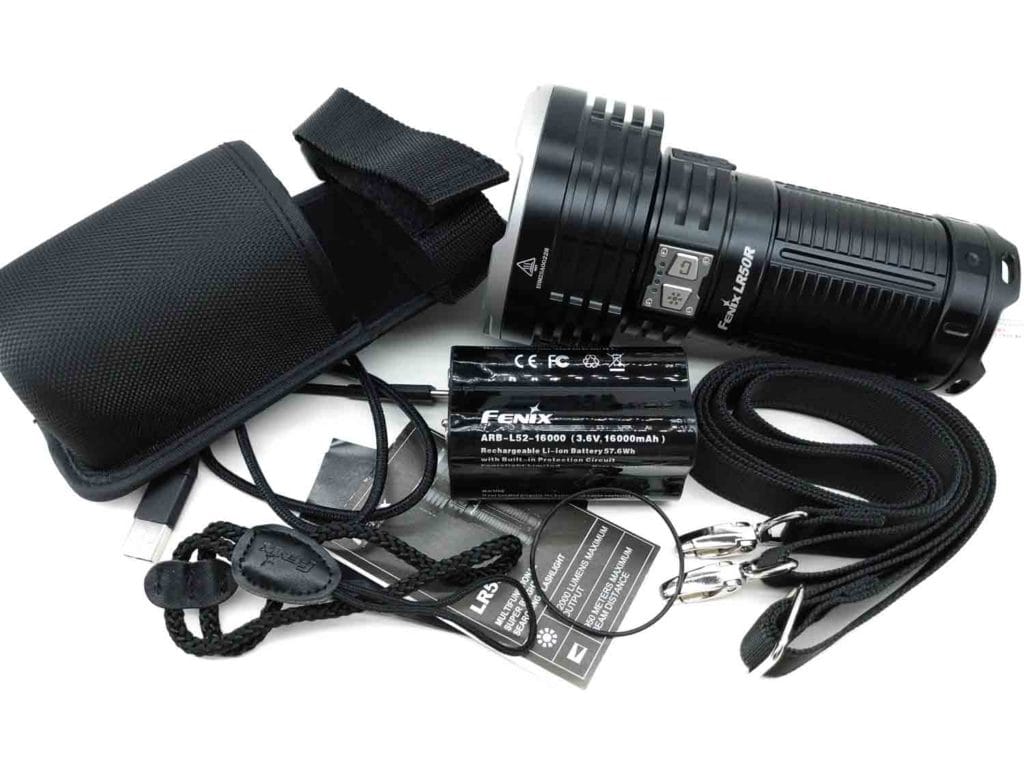
Flashlight in use
It goes without saying, but this bad boy is heavy. The first thing I noticed upon picking it up was the commanding heft; it feels like a tank. The battery tube is roughly soda-can size. The LR50R can easily tail-stand.
I was a bit shocked to find a wrist strap/lanyard in the package, as the LR50R seems too heavy for such a strap. But the one provided is quite thick and would likely work for a while if you needed it. The more likely scenario is the use of the included shoulder strap – it’s fairly strong and has nice metal clasps. The front mounting point also serves as a standard tripod socket for stationary lighting. The included holster is well made, consisting of a canvas material and hook-and-loop fasteners.
There are two switches. Both of them are e-switches and located on the side, towards the front of the light. The left switch is the “auxiliary” switch and the right is the “main” switch. Situated immediately above the buttons are four blue LEDs for indicating the battery status.
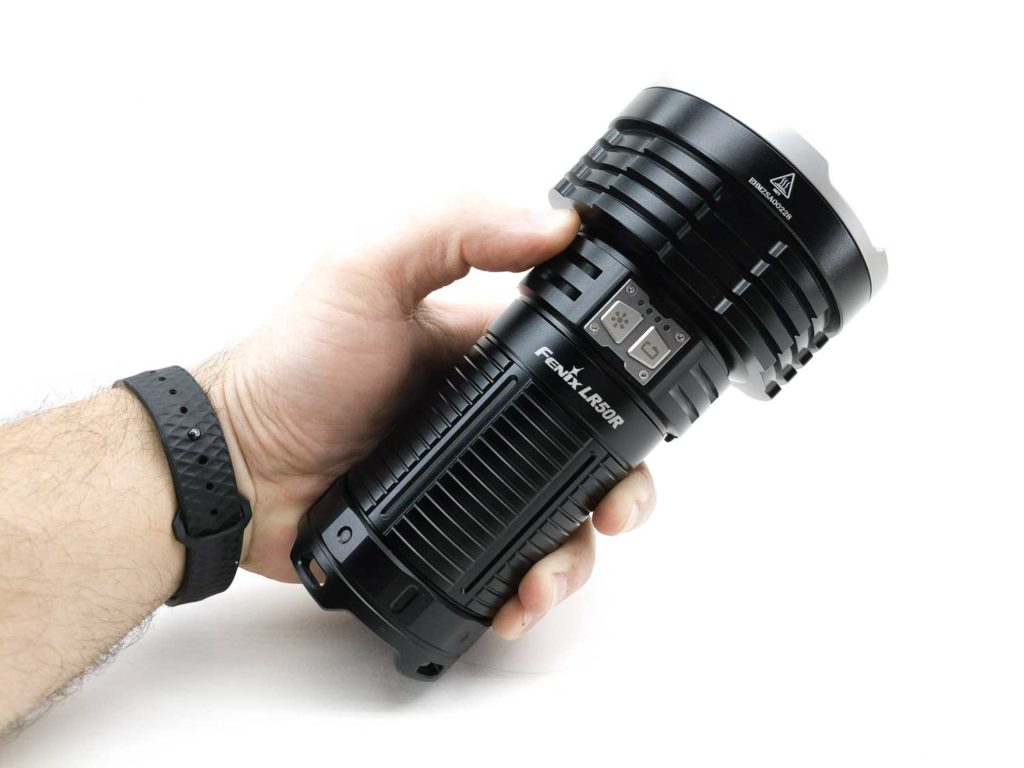
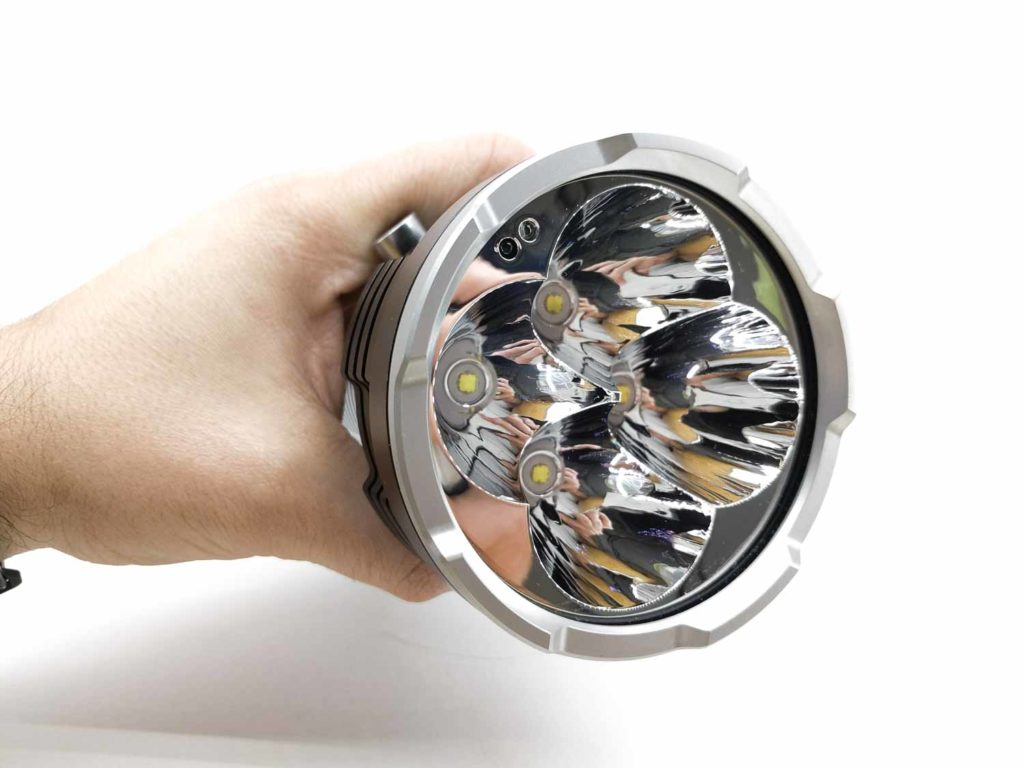
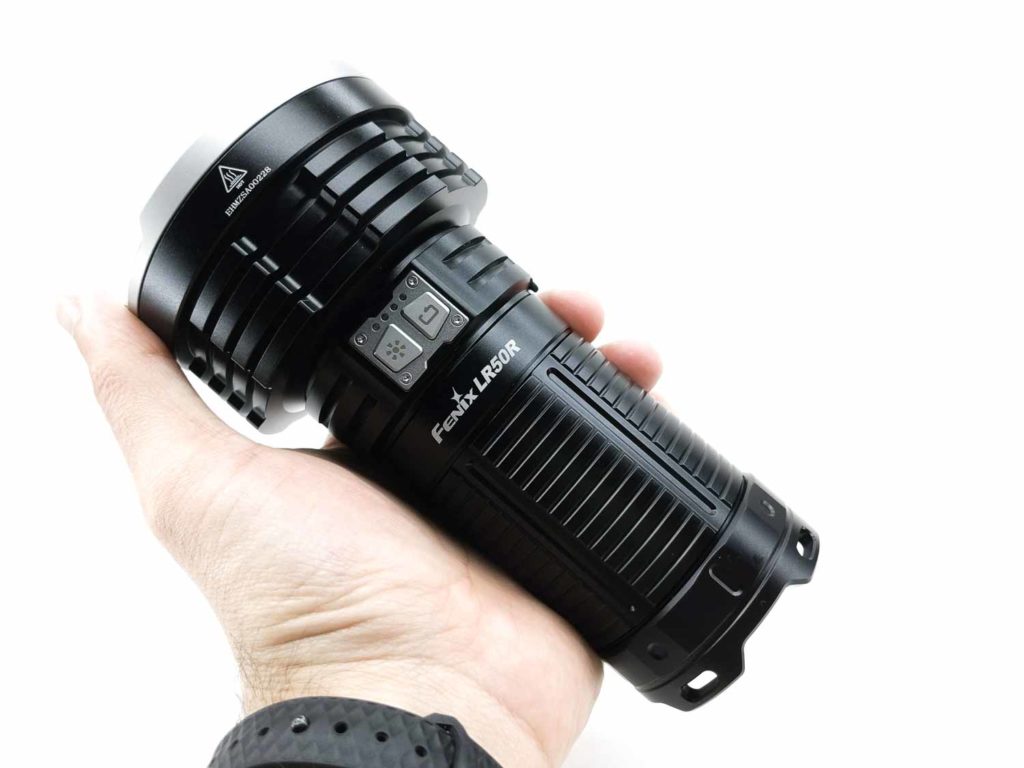
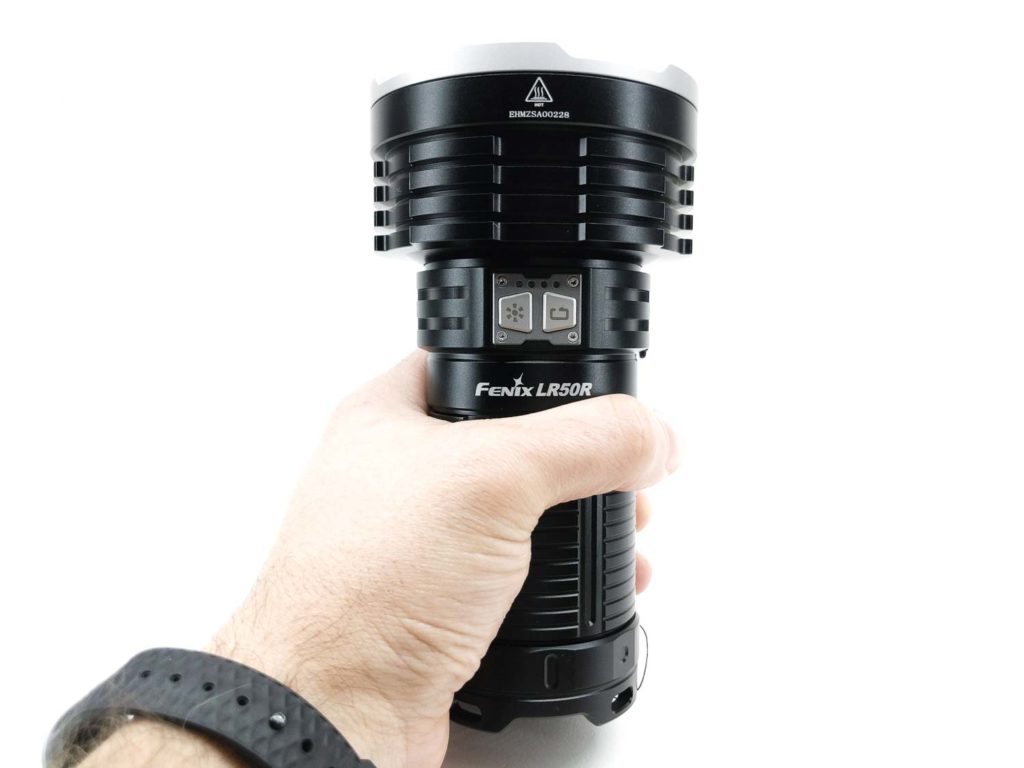
Build Quality, and Warranty
The Fenix LR50R forgoes the usual knurling and instead has a series of rings and grooves milled into the body that provides a reasonable amount of grip. The anodizing (HA III) on the aluminum is a satin black but does have a slight sheen to it. The square threads are cleanly cut, smooth, and come pre-lubed. Overall, the LR50R feels great in the hand and leaves no cause for concern regarding build quality.
Speaking of quality: the Fenix LR50R, like all Fenix products, comes with a Limited Lifetime Guarantee from Fenix Lighting USA.
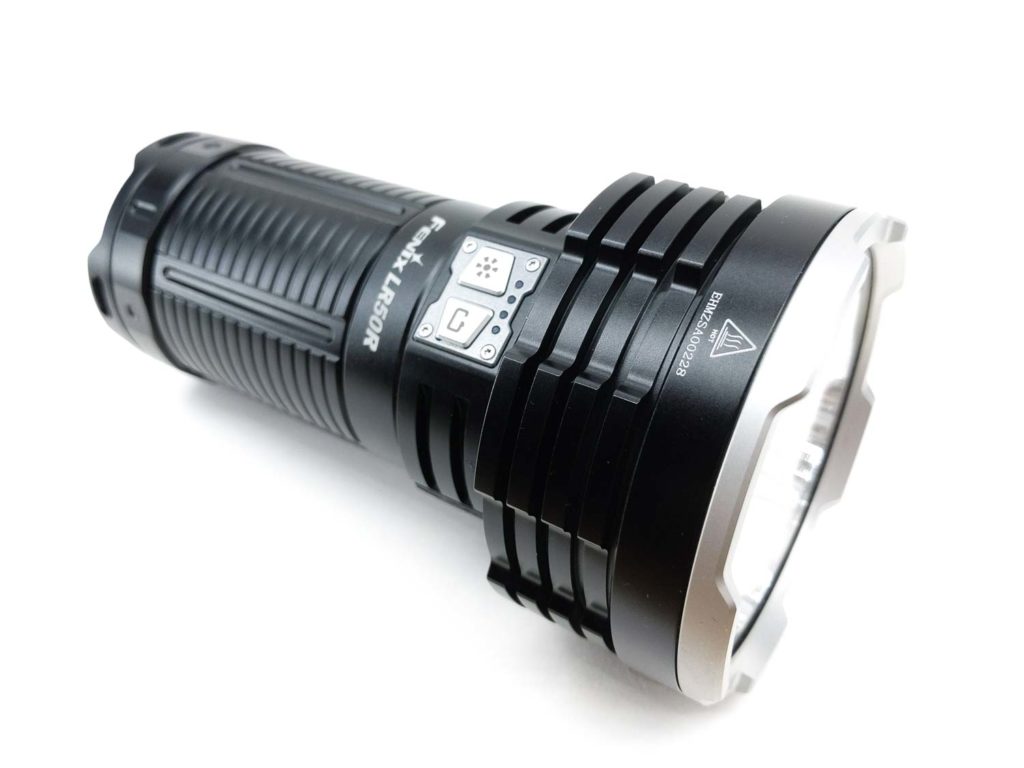

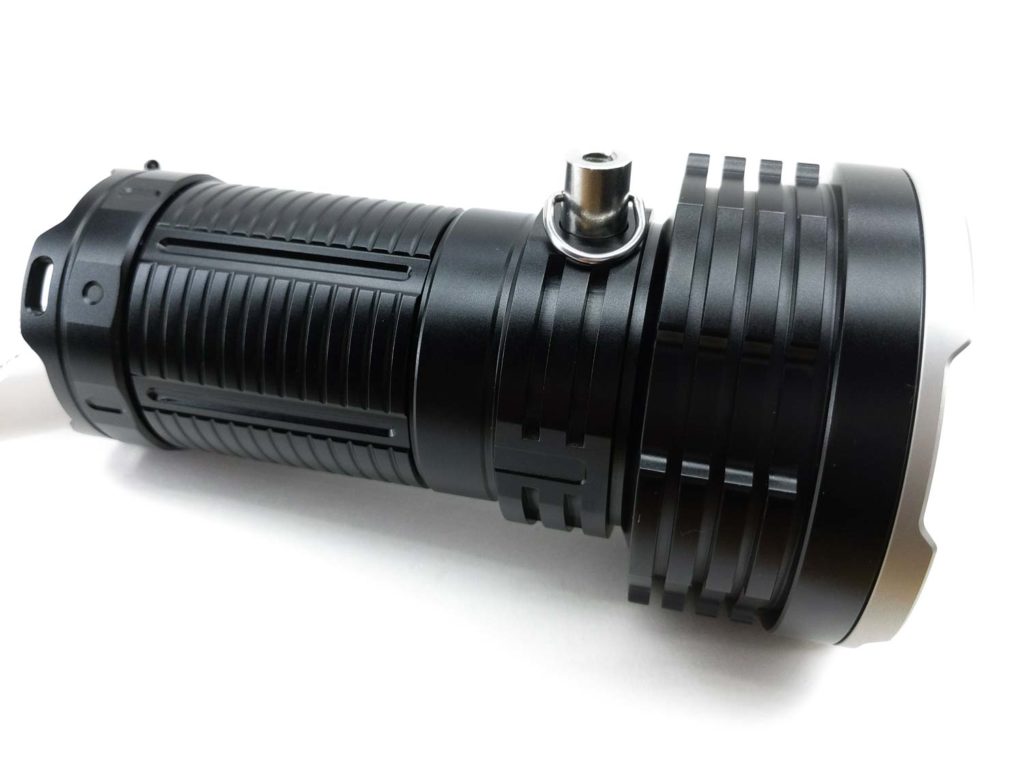
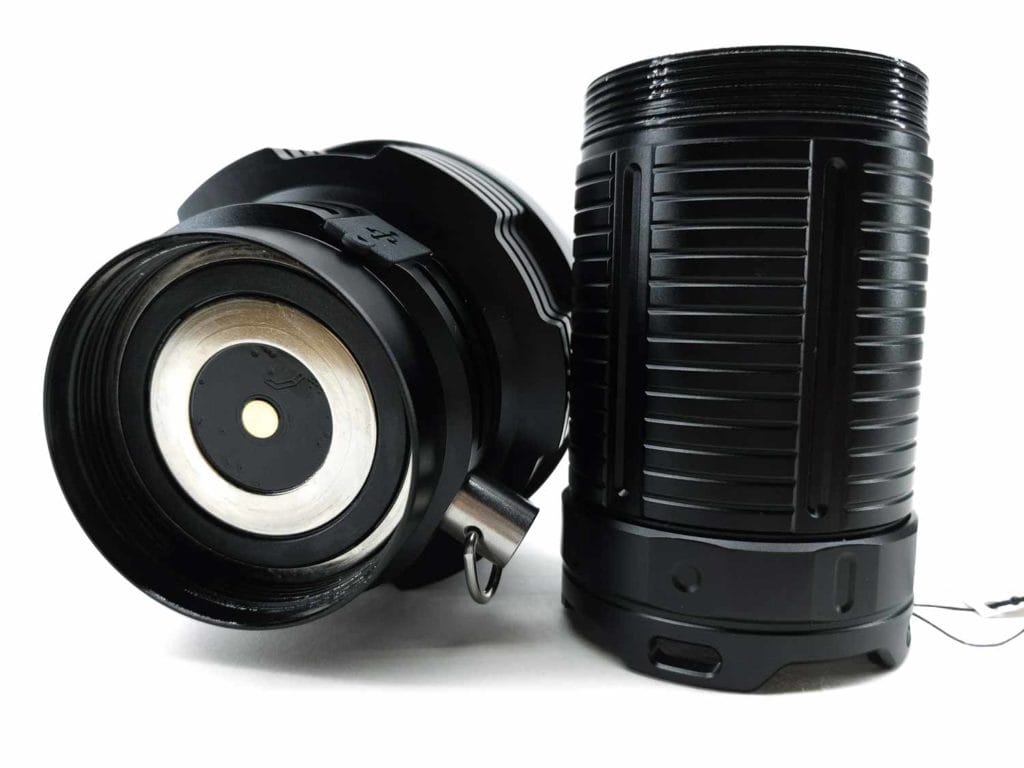
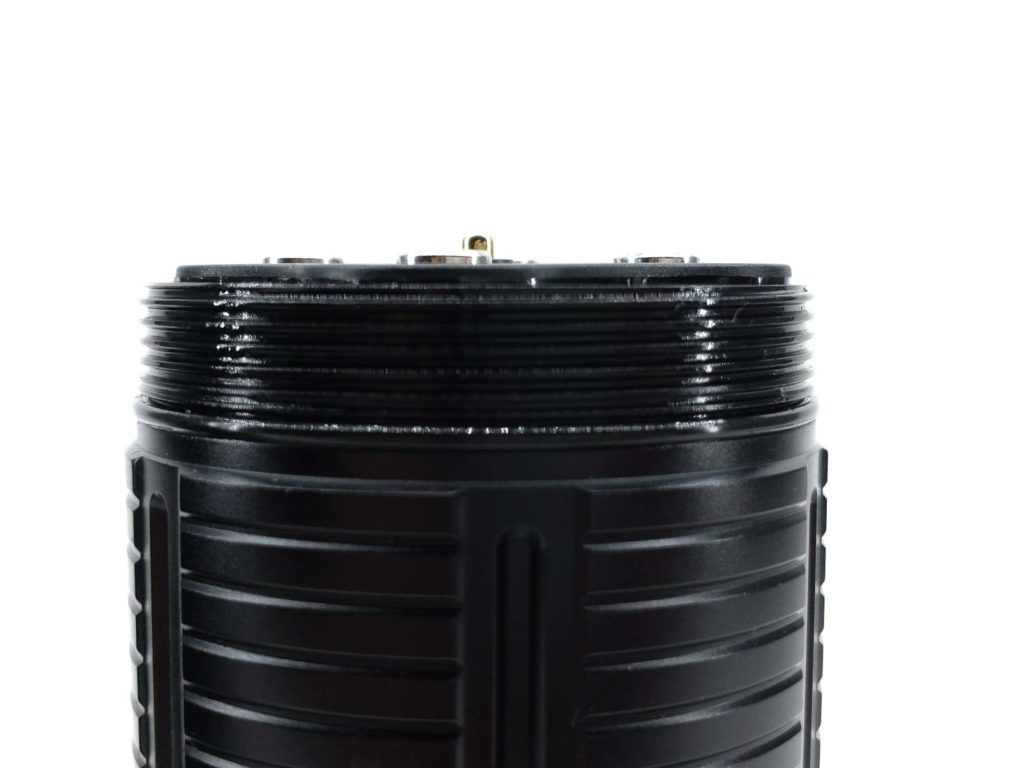
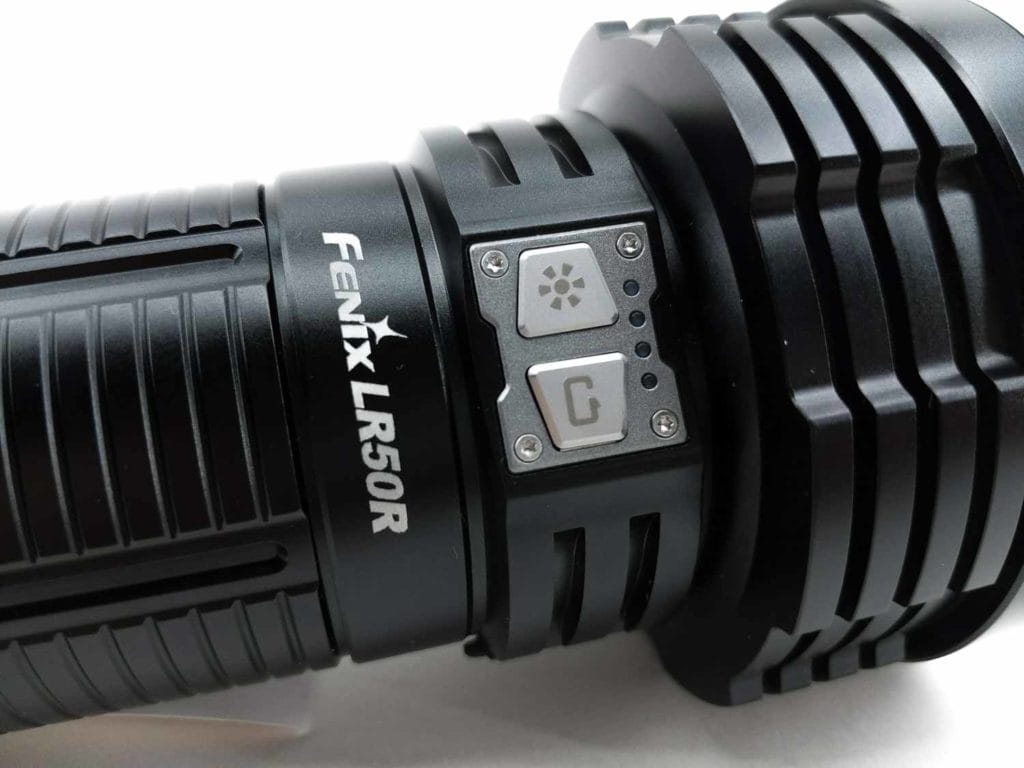
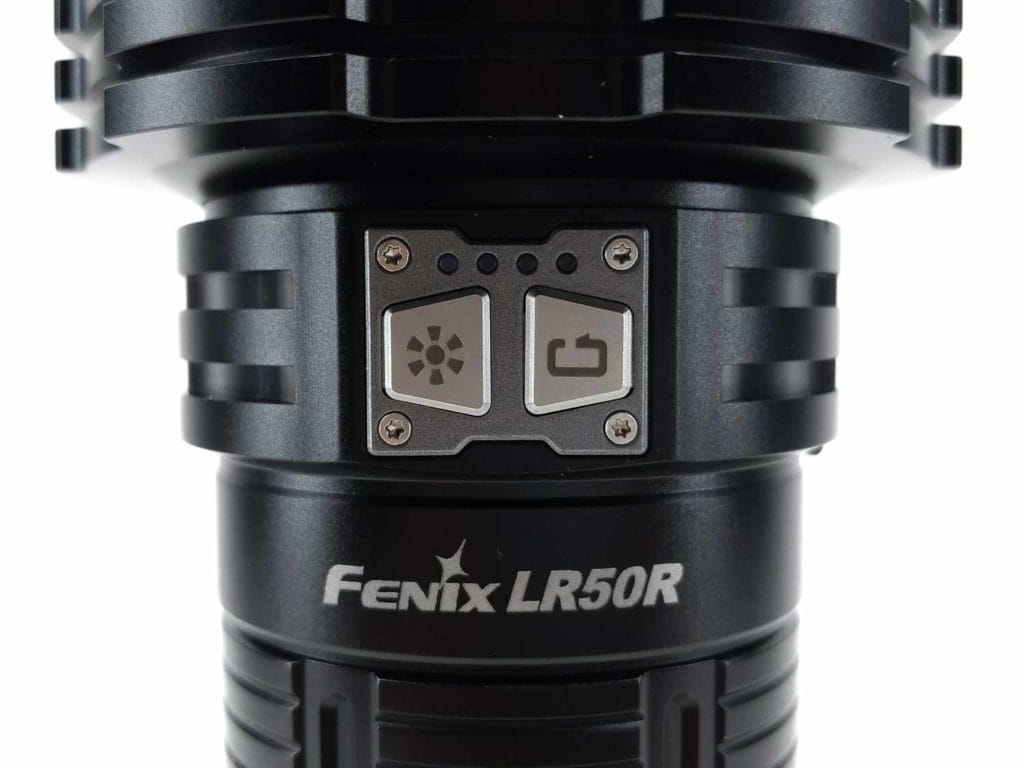
LED, Lens, Bezel, and Reflector
The Fenix LR50R comes with a moderately crenulated matte stainless steel bezel. That bezel protects what appears to be AR-coated glass. Below the glass is a four-leaf-clover shaped smooth reflector. A Luminus SST70 LED is situated at the bottom of each reflector. The SST70 is a 6V/12V quad-die LED with a 5050 footprint, a direct drop-in for the Cree XHP50. As expected, the LEDs are a bit on the cool side, perhaps around 6000K. Fenix claims that this reflector provides an 8° hotspot and 75° wide spill.
This combination definitely provides a huge amount of throw AND a huge amount of spill. I would imagine this combination being excellent for search-and-rescue type efforts where you would need to look across long distances while also lighting up a large area.
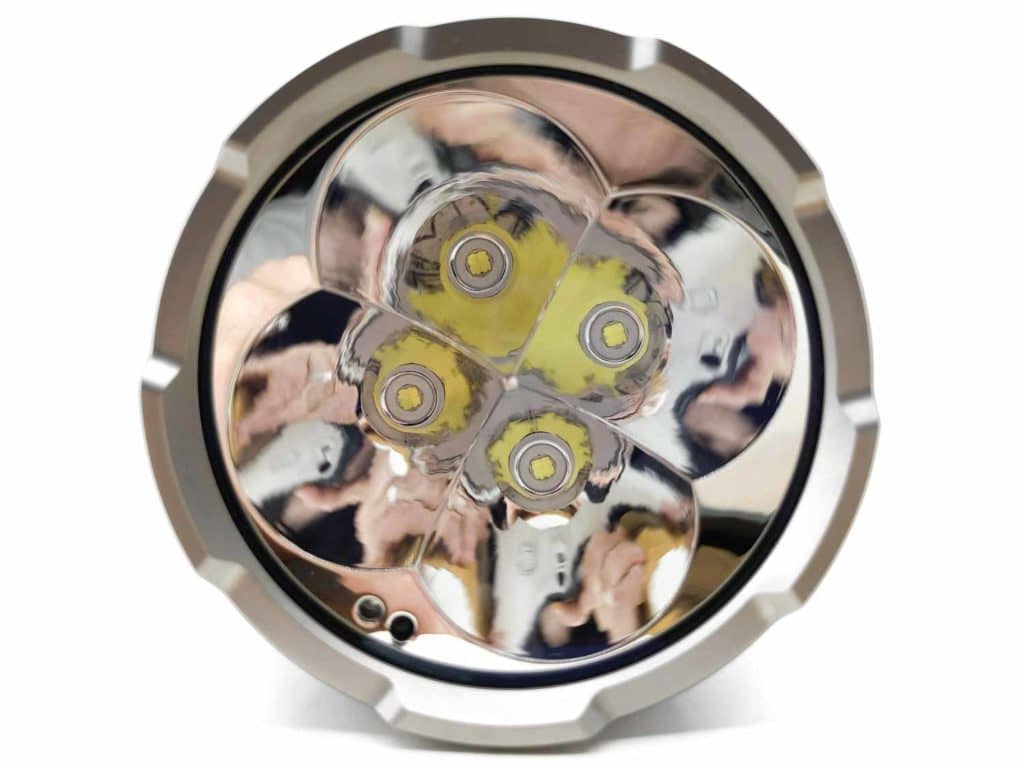
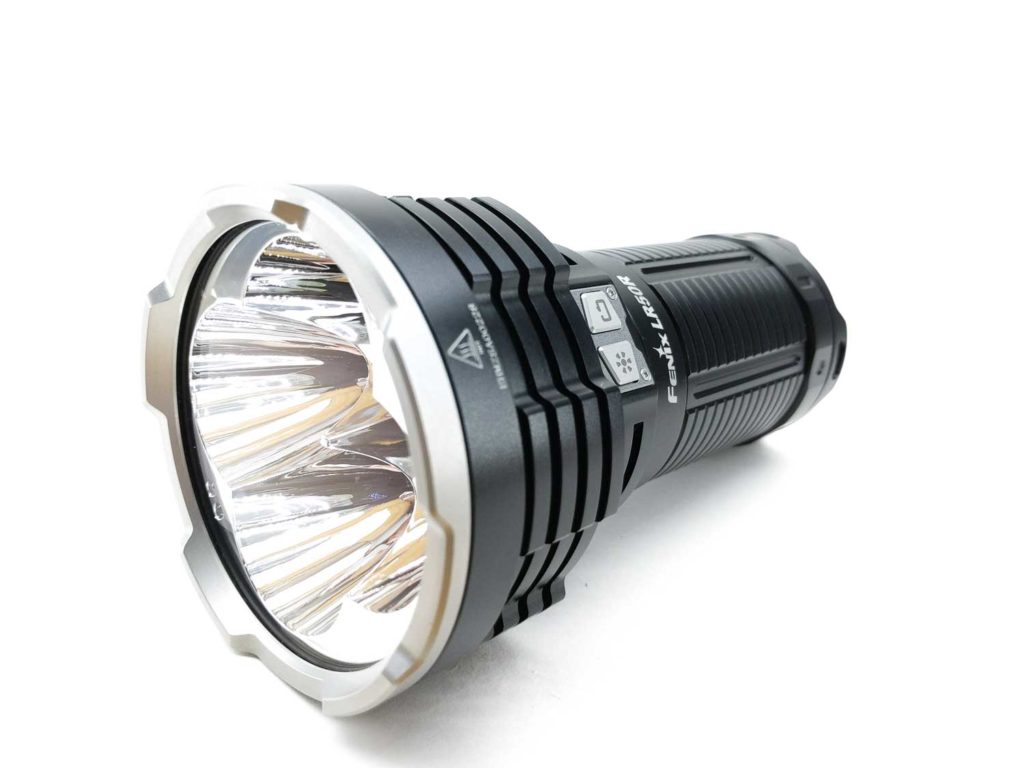
Dimensions and size comparison
- Length: 163 mm / 6.42 inches
- Head diameter: 88mm / 3.46 inches
- Body diameter: 60mm / 2.36 inches
Weight:
- EWith cells: 986 grams / 34.8 ounces
Flashlight size comparison
Fenix little and big brothers, from left to right: Fenix E25, Fenix LR50R
Large lights, from left to right: Astrolux FT03 Copper, Fenix LR50R, Convoy M21C-U
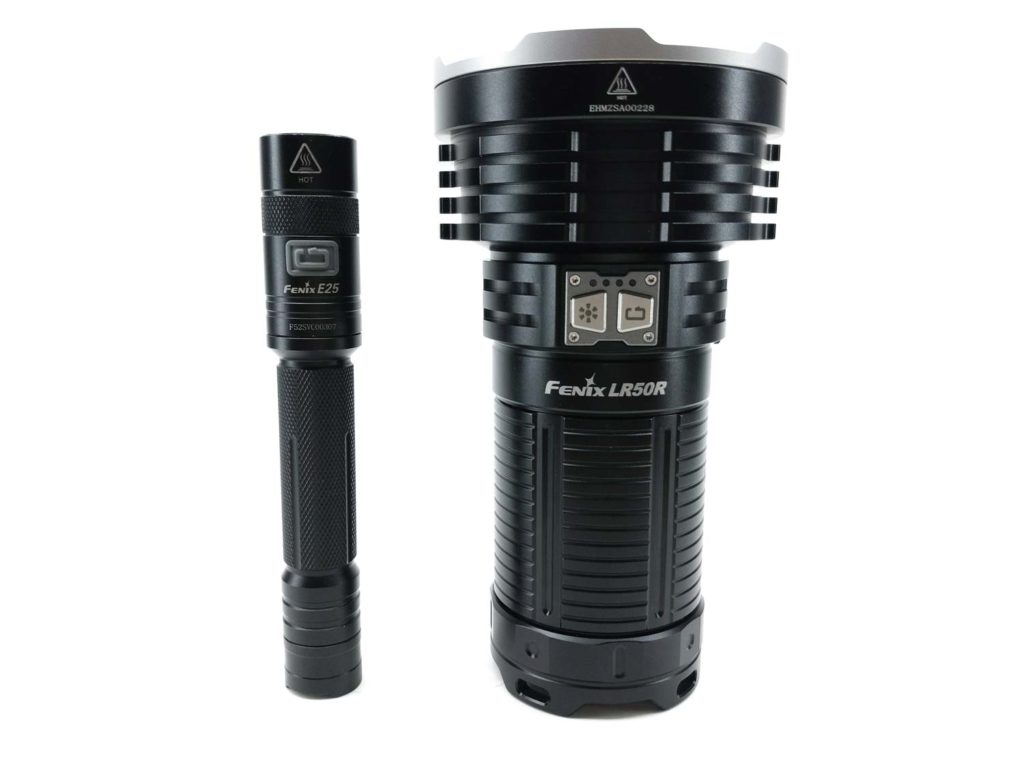

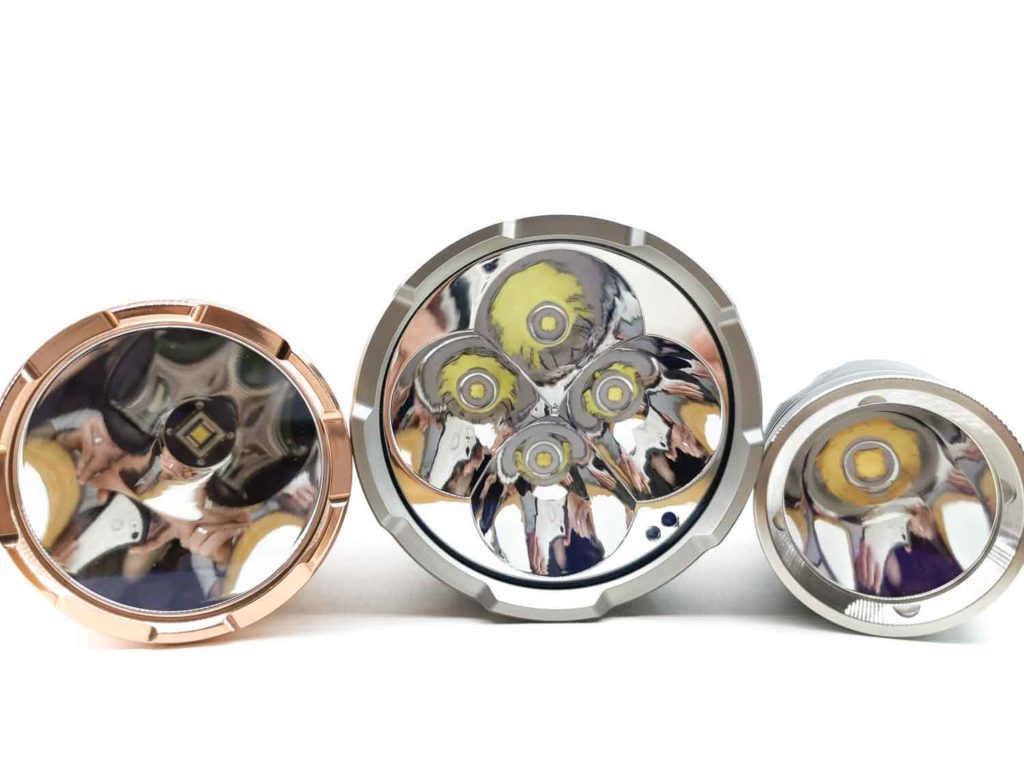
Driver & User Interface:
With the Luminus SST70 LEDs being 6V/12V, the Fenix LR50R must be using a boost driver. It appears to be very efficient and well regulated.
Sometimes when I see a two e-switch setup, I get concerned on how complicated the UI will be and if I’ll be able to remember how to use the flashlight. That might sound silly, but when you have a lot of flashlights, if each one is operated differently it can be a real challenge. I was very happy to find out that the LR50R isn’t difficult to use at all. I just needed to remember this rule: the left switch is for auxiliary functions; the right switch is for general use.
Modes: Eco, Low, Med, High I, High II, Turbo
From OFF:
- Auxiliary (left) switch, hold for 0.5 sec: Turbo (functional mode)
- Main (right) switch, hold for 0.5 sec: enter the previously used constant mode (general mode)
- Click (either switch): show battery indicator
From ON:
- Main (right) switch, click: cycles through: Eco > Low > Med > High I > High II > Turbo
- Auxiliary (left) switch, click: cycles through: Turbo > Strobe > SOS
- Hold either switch for 0.5 sec: turn off
Mode memory:
- There is mode memory in the general modes: it will remember your last-used brightness level
- This does not seem to apply if you’re using 21700 batteries instead of the battery pack, it will not have mode memory in that case.
- The functional modes (Turbo > Strobe > SOS) do not have mode memory. It will always go to Turbo first.
Low voltage warning:
- The flashlight will step down and eventually shut off.
Strobe/blinkies
- The functional mode includes both Strobe and SOS.
Lock-out mode:
- With the flashlight off, hold both buttons down for 3 seconds to lock the flashlight.
- Repeat the same action to unlock the flashlight.
- While locked out, pressing a button will cause the flashlight to blink twice.
PWM
- No PWM was detected.
Additional info: it doesn’t matter what mode you turn the flashlight on in. If you entered the general modes, you can still press the auxiliary button to access instant turbo. Vice versa, if you turned the flashlight on in functional mode (using the auxiliary button), clicking the main button will take you into the general modes sequence.
One more thing: the Fenix LR50R has an important safety feature built-in. It can detect if the face of the flashlight is close to an object (around 60mm) and will automatically switch to Eco mode to prevent damage caused by high temperatures. If you then move the light away from the object, the LR50R will go back to the previously used output level.
Batteries & Charging
The Fenix LR50R ships with a massive 16,000 mAh battery pack. It is clearly made up of 4x 4000 mAh 21700 batteries that have a protection circuit at the positive end and have been shrink-wrapped together. There is also a little pogo pin in the center that must tell the LR50R if the battery pack is installed. The absence of that would indicate that 21700 batteries are being used, which modifies the flashlight’s behavior. In addition to losing the mode memory when using 21700’s (sounds strange, but whatever), the LR50R eliminates the Turbo mode and High II becomes the brightest mode.
I must say that I’m very pleased that the LR50R can take 21700 batteries. Many flashlights that take a custom battery pack can only be used with that custom battery pack. But rather, Fenix provides the end-use with the ability to swap over to anywhere between 1 and 4 21700’s in a pinch. These must be button-top, long (probably protected) cells. I tried dropping in a Molicel P42A and it was much too short to make contact with the driver. I then tried a protected 21700 (with built-in USB-C charging) and it fit perfectly.
The Fenix LR50R also has a very nice charging and power bank system built-in. It uses a USB-C port and is compatible with many fast-charging protocols including PD3.0/PD2.0 and QC3.0/QC2.0. It can charge at up to a 4 amp rate (to the batteries). The included USB-A to USB-C cable appears to be fairly sturdy and is of the braided variety. It’s also hiding a little secret: the USB-A end pops off to reveal another USB-C plug for using USB-PD chargers!
Using my Fnirsi FNB38 USB meter, I performed a few charging cycles. Power draw ranged between 18 and 19 watts. Charging time consistently took between 4 hours 15 minutes and 4 hours 20 minutes, which falls in line with Fenix’s claim of a 4 hour charge time. I was able to confirm that both USB-PD and QC worked just fine. While the flashlight is charging, the 4 blue indicator LEDs light up in succession to show the charge progress. When the battery is empty, all 4 lights illuminate in order. When the battery is half full, the first 2 LEDs stay lit while the other two display the charging sequence. I really like this charging indicator; it’s much better than the usual red-green LEDs that I can’t tell the difference between.
As an added bonus, the LR50R can power your mobile devices. I used the included cable and connected the flashlight to my Pixel 3’s USB-C port. After pressing one of the LR50R’s buttons, my Pixel 3 showed “charging rapidly”, confirming that it was being fast-charged by the Fenix.
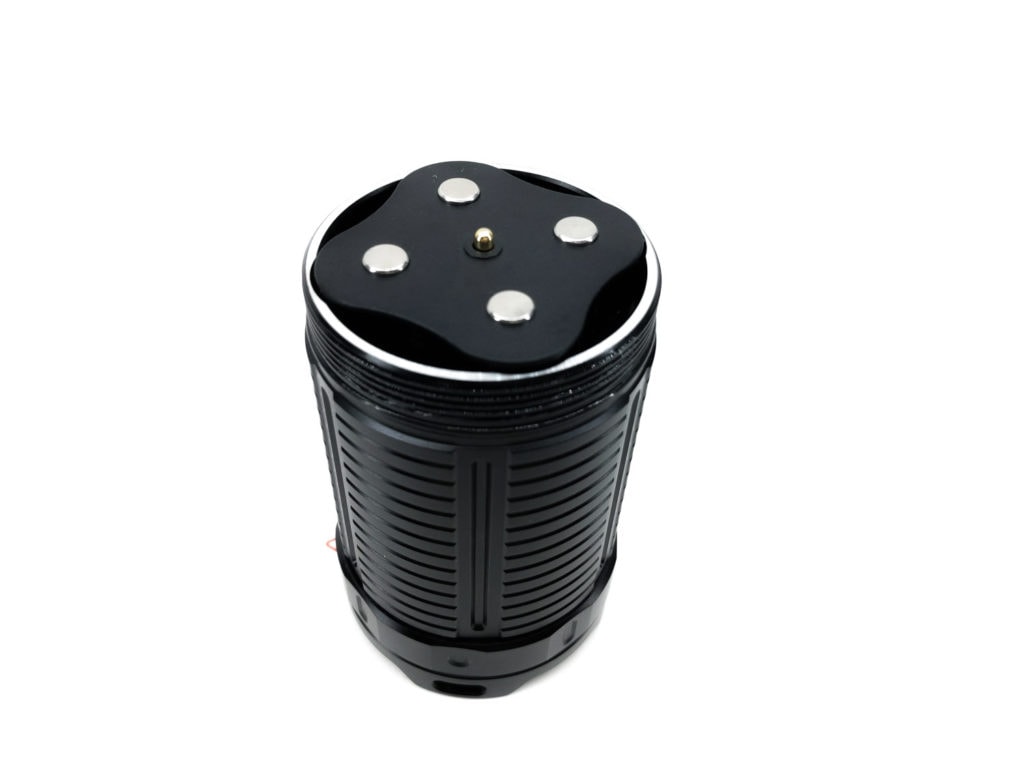
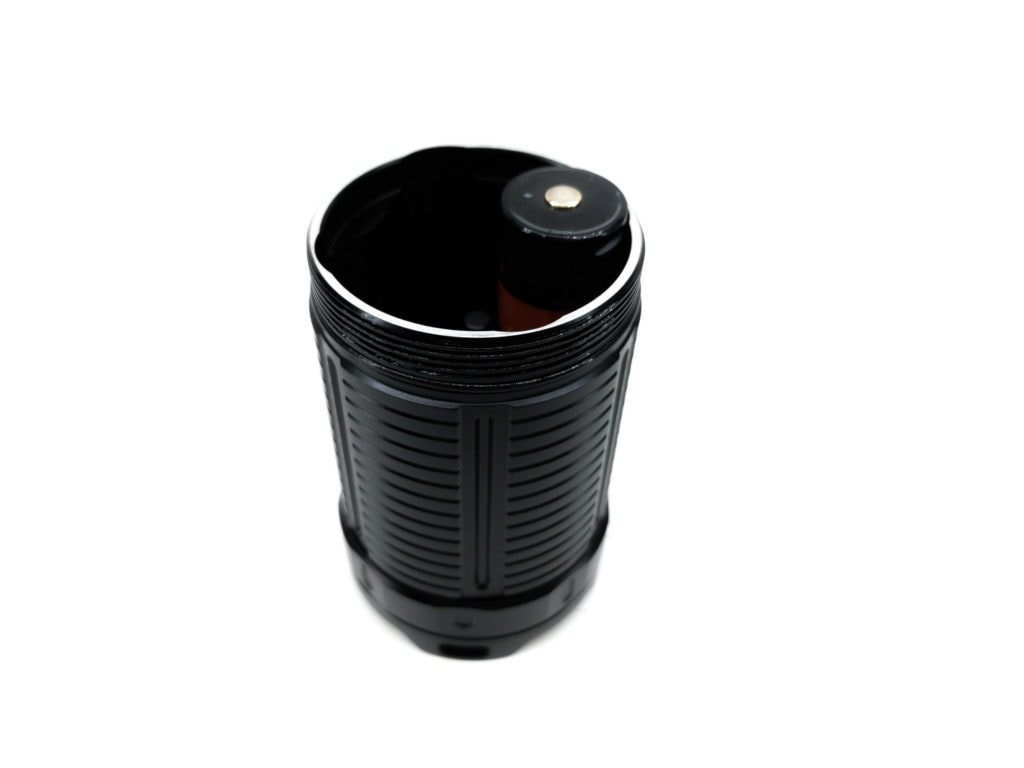
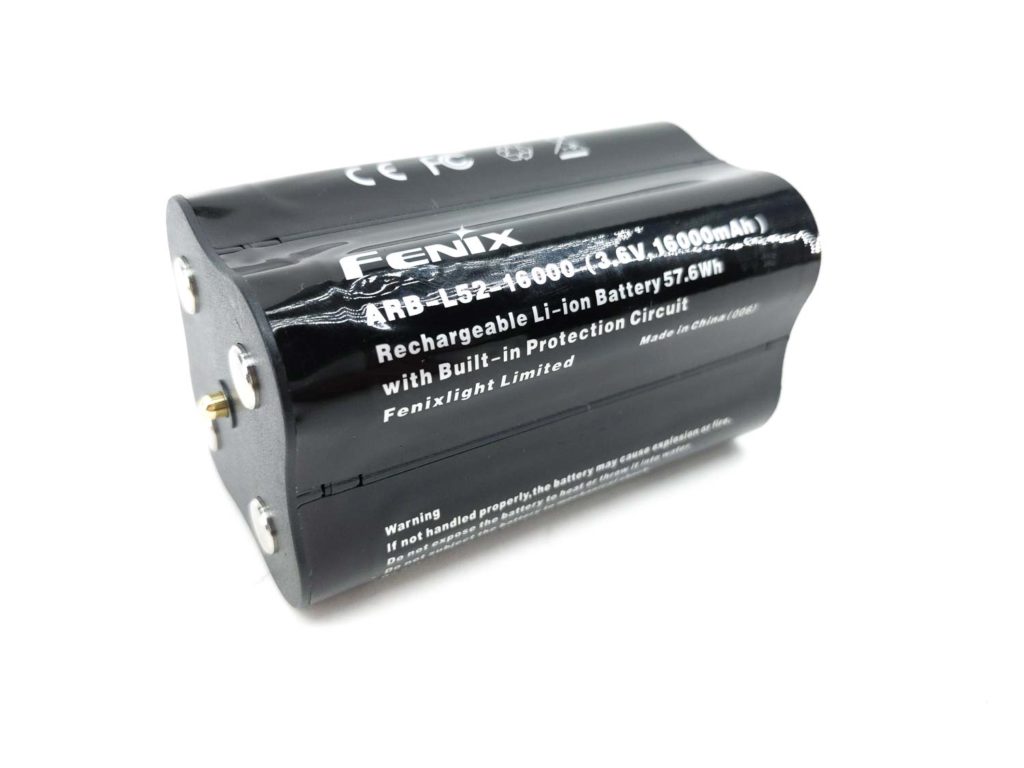
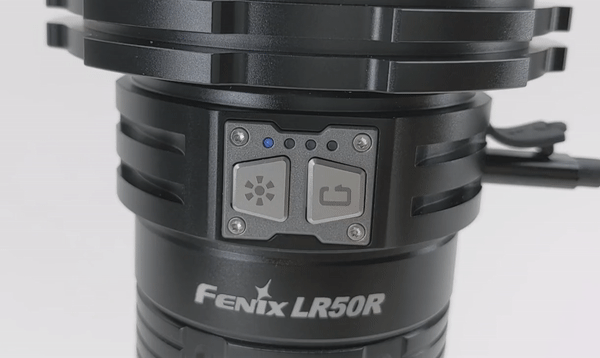
Performance
For current measurements, an ANENG AN8008 multimeter and UNI-T UT210E clamp meter were used. Lux was measured by a UNI-T UT383 BT at 5 meters. Lumens were measured in a homemade lumen tube using a TSL2591 sensor, calibrated with a Maukka calibration light. The temperature was monitored with an MLX90614 IR temperature sensor. Unless otherwise noted, testing was performed using the included battery pack.
Runtime graph
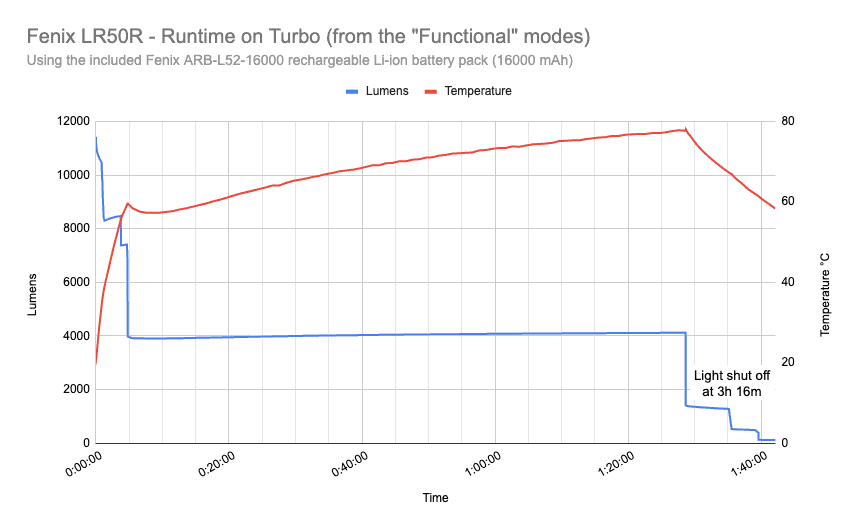
The first runtime I performed was the Turbo mode, accessed from the Functional mode group (using the auxiliary button). I measured output beginning at 11,424 lumens. It dropped steadily for the first 2 minutes, then settled in around 8,500 lumens until the 4-minute mark when the temperature regulation kicked it down to 4,000 lumens, where it stayed until the low voltage protection started kicking in. Once it got down to 4,000 lumens, thermal regulation didn’t take effect again. While the light stayed bright, the temperature event rose up to 77°C which is a bit higher than I’m comfortable with. But if you have a vital search-and-rescue mission going on, I’d rather don a protective glove and have the light perform exactly as it did.
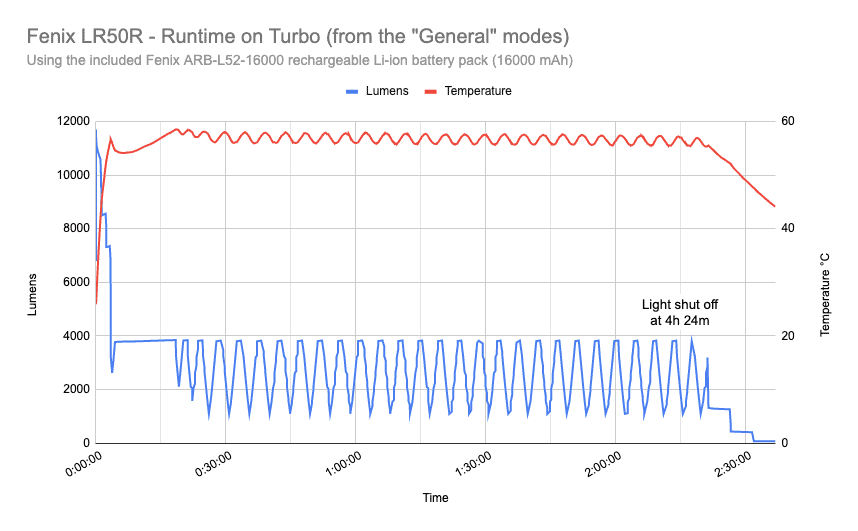
I ran the same test again, but I activated Turbo from the General mode group (using the main button). While the initial part of the test was the same, thermal regulation actually kicked in after the light stepped down to 4,000 lumens. The LR50R stayed around 55°C, which is nice, but it also caused huge swings in the output while the thermal regulation attempted to gain control of the situation. I was a bit shocked to find this, as I don’t believe it was mentioned in the manual: Turbo acts differently depending on which mode group you activate it from.
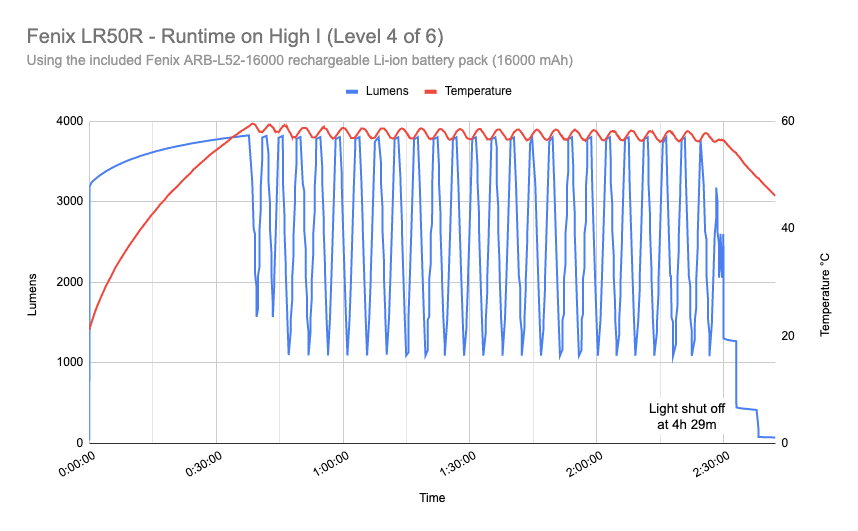

The tests for the High I and High II modes acted similarly to Turbo from the General modes group: it stayed regulated until the LR50R was thermally saturated, and then it went into wild output swings as it regulated temperature to around 56°C. Thankfully, with the LR50R being quite large, it takes a while before it gets heat-soaked.
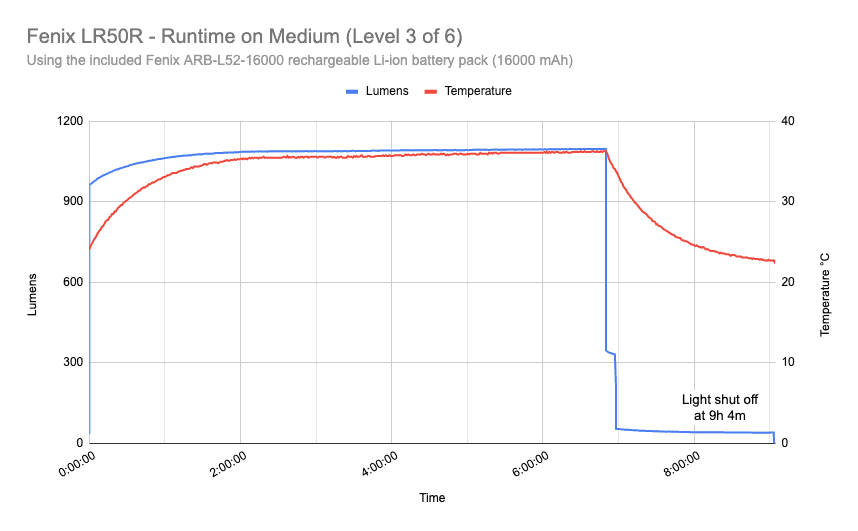
In Medium mode, the Fenix LR50R easily handled the 1089-lumen output without breaking a sweat. It stayed around 35°C in a 22°C room.
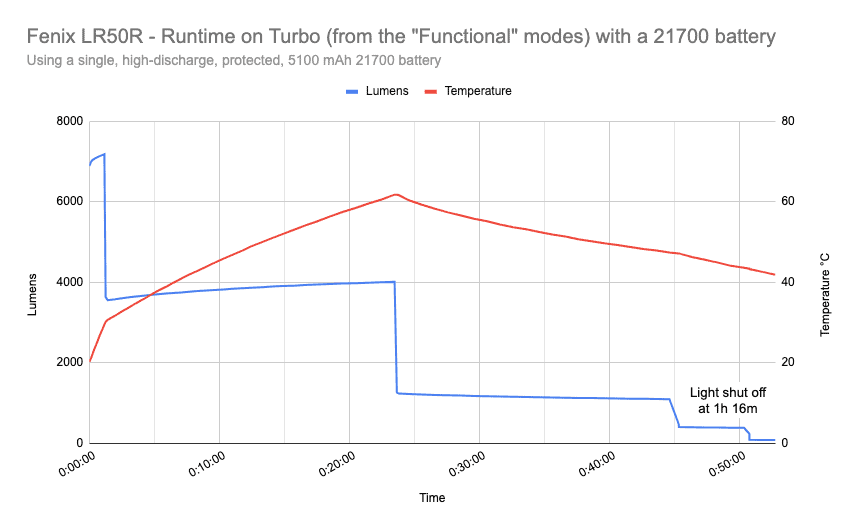
To wrap up the runtime testing, I also performed a test using a single 5100 mAh protected 21700. I used Turbo from the Functional modes. The LR50R started out at 6,887 lumens and ramped up slightly over the first minute before dropping down to just under 4,000 lumens. It held that until the 23-minute mark, then dropped down to 1,235 lumens. Low voltage protection started kicking in at 44 minutes.
Lumen measurements (for each mode)
| Mode | Specified | At turn on | 30 sec | 10 minutes |
|---|---|---|---|---|
| Eco | 50 lm | 51 lm | 51 lm | – |
| Low | 350 lm | 315 lm | 326 lm | – |
| Med | 1000 lm | 963 lm | 965 lm | 996 lm |
| High I | 3000 lm | 3188 lm | 3238 lm | 3534 lm |
| High II | 6,000 lm | 6,704 lm | 6918 lm | 4923 lm |
| Turbo | 12,000 lm | 11,698 lm | 10,849 lm | 3804 lm |
I feel that the lumen measurements that I took are well within Fenix’s claims. I feel quite confident in saying that yes, I believe the LR50R can actually do 12,000 lumens (albeit for less than a minute).
Throw numbers:
| Mode | Specs: Candela | Measured Candela | Throw: Meters | Throw: Yards |
| Eco | 1200 | 1000 | 63 | 69 |
| Low | 6850 | 6000 | 155 | 169 |
| Med | 19800 | 20000 | 283 | 309 |
| High I | 58200 | 65600 | 512 | 560 |
| High II | 118400 | 138700 | 745 | 815 |
| Turbo | 225,750 cd | 219,200 cd | 936 meters | 1024 yards |
Again, my measurements line up quite well with Fenix’s. Granted, I’ve always been of the impression that Fenix’s output claims have been pretty truthful.
Beamshots
- The farm shed in these beamshots is 107 meters (117 yards) away. Pictures were taken with my Pixel 3 using ƒ/1.8, ⅕ second exposure time, ISO800, and 5000K white balance.
- Fenix LR50R
- Astrolux FT03 (SBT90.2)
- Convoy M21C-U (XHP70.2)
- Brinyte B158 (XP-L HI)
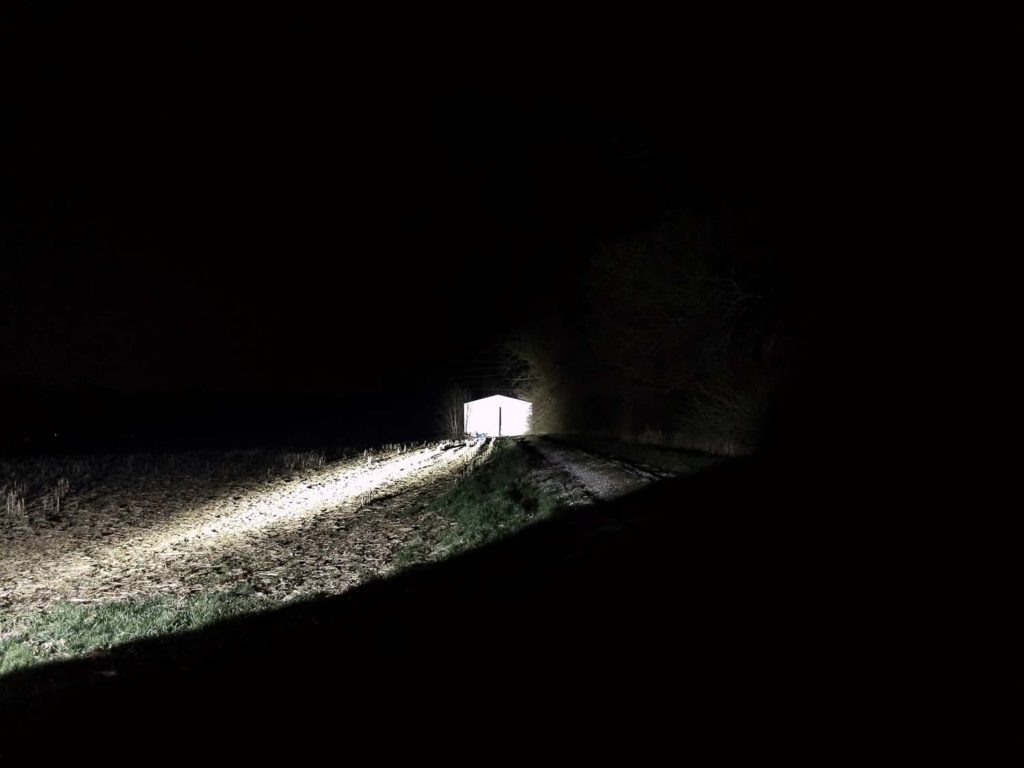

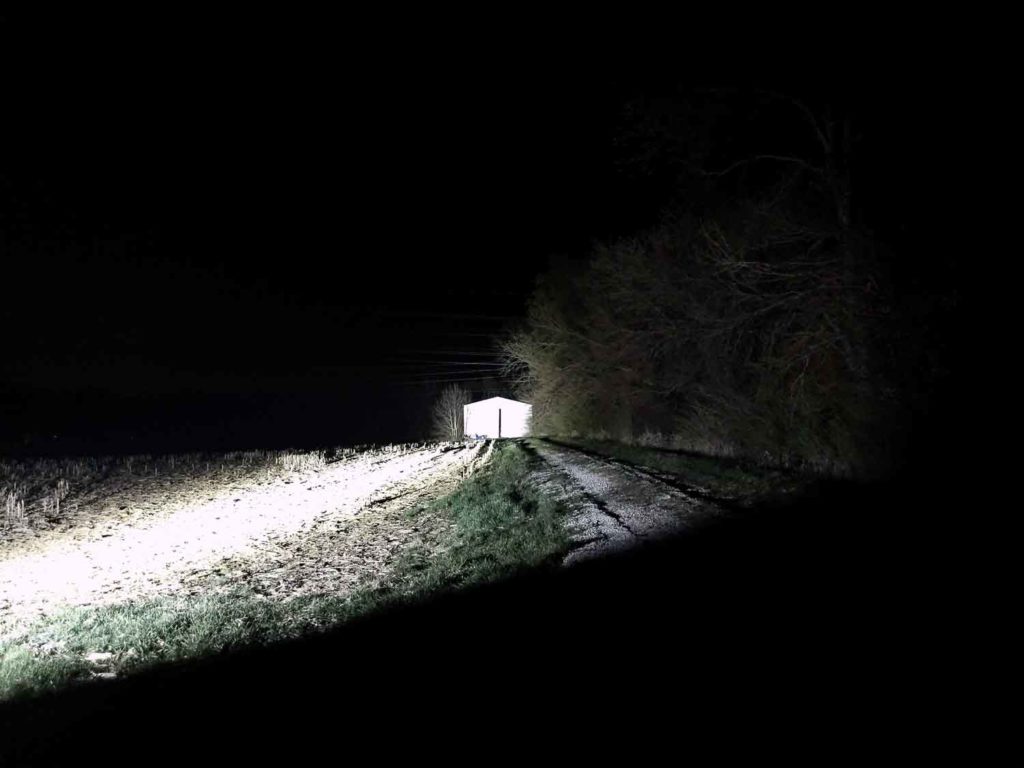
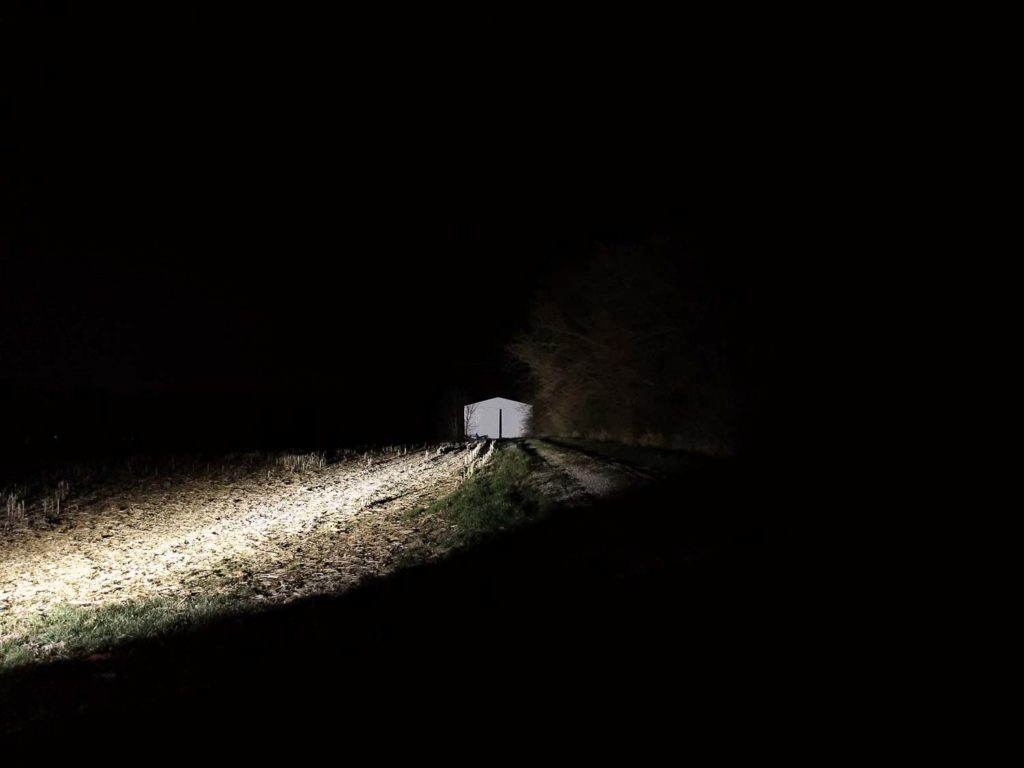
Disclaimer: This flashlight was sent to me for review at no cost by Fenixlighting. I have not been paid to review, nor have I been holding back on problems or defects.
Explanation on star ratings:
- – Avoid: my phone flashlight would be a better choice
- – Poor: significant defect or issues, much better options available at the same price
- – Average: some defects or issues
- – Good: recommended (minor issues)
- – Great: highly recommended
Final Verdict
Pros
- Impressive throw
- Huge wall of light
- Long runtimes
- Built-in fast-charging via PD & QC
- Power bank functionality
- Easy UI
- Proximity detection
- Nice accessories
- Can use 21700 in a pinch
Cons
- Thermal regulation needs work
- Mode memory

4.5 stars: ★★★★⋆
The Fenix LR50R really is awe-inspiring. Not only does Fenix claim 12,000 lumens and 950 meters, but they actually deliver upon it… at least for the first minute. It’s made to be a high-performance long-range spotlight that can reach out and illuminate a large area. I feel like they nailed that goal. And with the built-in charging, included battery pack, and good accessories, this is a really nice all-in-one kit.
But what didn’t Fenix get quite right? Thermal regulation. I’m glad it’s there – it keeps temperatures in check. However, it also causes pretty wild swings in output (4000 lumens to 1000 lumens and back). It’s visible and it can be distracting. Thankfully, with as much thermal mass as the LR50R has, it takes a while before it gets to that point. And if you’re outside with decent cooling, it might not even happen. One other minor nit-pick: I’ve grown to not appreciate mode memory. Will my flashlight come on in 50 lumens? Or 12,000 lumens? Who knows, I can’t remember.
All in all, I feel like Fenix got a lot right here. The Fenix LR50R is big, bold, and bright. It’s easy to use. And next time Lassy signals to me that little Timmy fell in a well, I know exactly which light I’m reaching for.
Buy Fenix LR50R with our discount code
Get 10% off every purchase at Fenix Lighting US, by using our exclusive 1lumen discount code: 1lumen10
1lumen selects and reviews products personally. We may earn affiliate commissions through our links, which help support our testing.